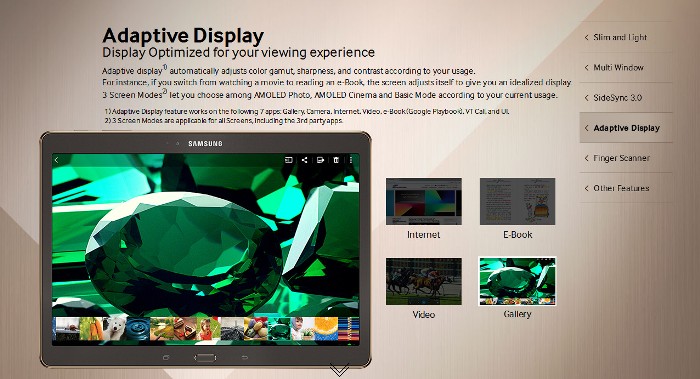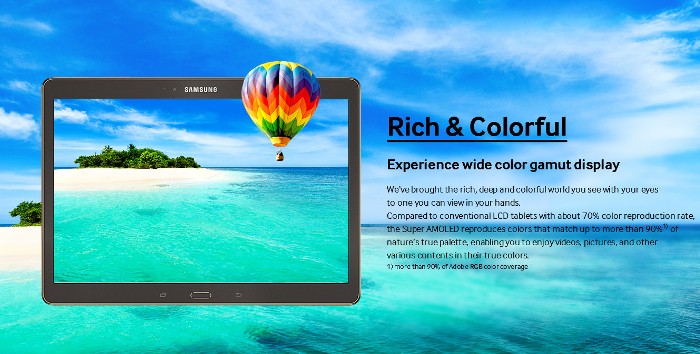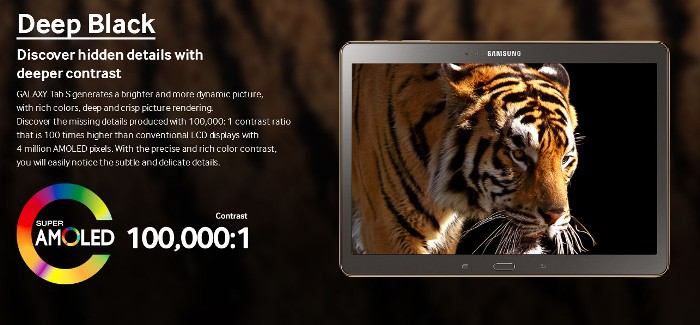Samsung’s New Line of AMOLED Displays Now Becoming Color Accurate

Cropped screenshot from the official Samsung Galaxy Tab S microsite (http://www.samsung.com/global/microsite/galaxytabs/)
Like them or hate them — Samsung’s Super AMOLED displays have become some of the best displays on mobile devices at present. They are some of the reasons why the Galaxy line of devices has become very successful. They show a distinctive “punch” that makes images look more vivid and more colorful. To some, they are offensively oversaturated but to others they create an attractive appeal. However, one of the major criticisms on Super AMOLED displays is their problem with color accuracy. They can show great images but they fail on displaying the right colors.
Since Samsung adopted the diamond pixel array for their Galaxy S4 flagship smartphone, the complaint about their displays having a bluish overlay on them went away. In its place, however, comes the greenish tint that is especially noticeable when showing whites or very bright images. This is mostly due to the presence of more green subpixels in the display. Unfortunately, they haven’t figured out how to make things appear natural-looking (white whites, not greenish) in the same way the supposedly green star of our solar system appears white as we pointed out in an earlier blog post about science and tech misconceptions.
Well, things are about to change with the release of Samsung’s newest Super AMOLED displays. The Korean tech giant finally decided to work on the calibration aspect while doing some improvements on the AMOLED panels and glass protection to ensure color accuracy along with higher brightness and less screen reflectance for better outdoor visibility.

Cropped screenshot from the official Samsung Galaxy Tab S microsite (http://www.samsung.com/global/microsite/galaxytabs/)
Ignore the Ads
Samsung recently released a series of ads promoting the new generation of Super AMOLEDs that supposedly offer vast improvements over their predecessors. If you are keen on with logic and details, you will likely not appreciate the ads. They present ridiculous comparisons with LCD that misleadingly show purported advantages.
One of these ads supposedly shows how the vibrant display facilitates good online shopping. In the ad, the online shoppers supposedly got dull colored products because they were using tablets with LCD displays. Apparently, Samsung thinks LCDs are duller and that their color gamut affects shopping results, while Samsung has a great bright and vivid display that allows shoppers to see “real” product colors. This is of course illogical since a shopper who uses a dull display should be getting something with richer colors while those who use a tablet with richer displays are bound to get products that look less punchy than what they were seeing on their devices.
Anyway, as we said, if you want to appreciate how improved the Super AMOLED displays have become, it would be better to shun the ads and just go to the scientific analysis to avoid getting turned off by Samsung’s exaggerated and unrealistic advertising.

Cropped screenshot from the official Samsung Galaxy Tab S microsite (http://www.samsung.com/global/microsite/galaxytabs/)
Display Analysis (Galaxy S5 QHD)
The guys at AnandTech did an excellent job providing a detailed evaluation of Samsung QHD Super AMOLED display. This is not the same display found on the standard Galaxy S5. It is the display on the updated Galaxy S5 (S5 LTE-A) announced to be limitedly available to South Korea at the moment. It packs a higher resolution at 2560×1440 pixels or four times of HD resolution (1280×720).
As analyzed, the display generated a maximum brightness of 368.1702 nits. This is not a very impressive number considering that the iPhone 5 yields nearly twice as much brightness. However, the white point color temperature of the display has improved. It is now at 6,541K, which is very close to the 6,504K standard established as the desirable display temperature. Grayscale accuracy has also significantly improved at 3.2955, which is now closer to that of the iPhone 5’s LCD display. The Galaxy S3 scored 4.5780 for this. On the other hand, display saturation accuracy has also become better, with the display scoring about the same number as the iPhone 5S. Anyway, the iPhone 5S display is regarded by many as the standard for a good mobile display. The same is true with GMB accuracy.
Display Analysis (Galaxy Tab S)
Even the first ever Super AMOLED displays on the Samsung tablet line have become noticeably better. Display experts at DisplayMate regard the Galaxy Tab S as the tablet with the best screen. DisplayMate conducted extensive laboratory tests and measurements before concluding that it offers the best performance among known tablet brands. The Galaxy Tab S is deemed to have the highest color accuracy, lower screen reflectance, best contrast ratio, and best viewing angles. Also, just like the other Galaxy devices released recently, the tablet comes with different screen modes and color management tools to allow users to switch to their preferred colors since there are still those who don’t really care about color accuracy but would prefer seeing that “punch” they were accustomed to with the older AMOLEDs.

Cropped screenshot from the official Samsung Galaxy Tab S microsite (http://www.samsung.com/global/microsite/galaxytabs/)
It’s definitely great seeing how OLED technology has advanced. The criticisms over the pentile matrix pixel arrangement adopted by Samsung a couple of years ago has been more than satisfactorily addressed. AMOLED or OLED displays in general are an advantageous option for mobile devices since they are power efficient. They only produce light when an image needs it unlike LCDs that have their backlighting continuously turned on even when the display supposedly shows a dark scene or even a pitch black solid color.